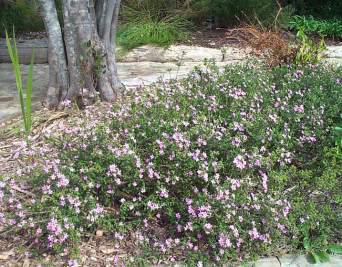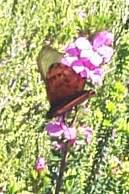Acmadenia heterophylla
Acmadenia heterophylla P.E. Glover
Family: Rutaceae
Common names: variable-leaf acmadenia
Introduction
This is a delicate looking shrub with starry pink flowers and a sweet lemony scent when touched. It belongs to the citrus family (Rutaceae) with most of the members commonly called buchu because of their aromatic leaves. Best known is the real buchu, Agathosma betulina, which is widely used in medicine. But this little shrub, Acmadenia heterophylla, also deserves a closer look from visitors and gardeners.

Description
Description
Small and compact it grows to about 400 mm high, looking neat and green throughout the year. The dark green leaves are tiny with small hairs all along their edge and oil glands that emits the scent. Hardly ever without a flower, the bushes are covered with deep pink flowers at the tips of the stems during autumn, winter and spring. Each of the flower's five petals has a prominent dark pink nectar guide leading to the centre of the flower.

Distribution and habitat
Distribution description
Acmadenia heterophylla naturally occur on the hills and limestone outcrops around Bredasdorp, Caledon and Mossel Bay in the southern Cape.
Derivation of name and historical aspects
History
There are 33 species in the genus Acmadenia and they are mainly found in the southern and south western Cape. In this family, Rutaceae, of which the leaves of the plants are dotted with aromatic oil glands that produce fragrances unique to each species, there are also other interesting genera like Agathosma, Adenandra and Coleonema. Unfortunately these plants are not easy to obtain, but are sure to become more popular as they prove to be such excellent garden plants.
Ecology
Ecology
Visiting bees are usually the pollinators, but butterflies also visit the plants.

Growing Acmadenia heterophylla
Grow
Acmadenia heterophylla easily adapts to growing in the garden where it requires full sun and well-drained soil. It will benefit from well prepared soil with compost and a thick layer of mulch. The plants also respond well to slow release fertilizer like 3:1:5. Although natural to limestone, Acmadenia heterophylla will also tolerate acidic soils. These are excellent plants for coastal gardens.
The plants can be propagated by seed or cuttings, but both require some skill. Fresh seed must be sown in autumn.
Cuttings have the advantage of producing a larger flowering plant faster than seedlings. Semi-hardwood cuttings, 50 to 70mm, are taken from the current year's growth (August to early October). Prepare cuttings by making a clean cut below the node and remove the third of the foliage. Dip the base of the cuttings in a rooting hormone such as Seradix 3. Firmly place cuttings in a medium of 50% bark and 50% polystyrene. Ideally these cuttings should now be placed in an well-aerated propagation unit with a bottom heat of 24-degree Celsius. Rooting occurs in 9 to 11 weeks. Carefully pot the rooted cuttings using a well-drained humus rich fynbos potting medium (2 parts leafmould, 1 part coarse sand). Plants will be ready for planting in 7 to 8 months. Feed regularly with a well balance nutrient. Yellow leaves can be treated with an application of iron chelate.
Credits
Liesl van der Walt
Kirstenbosch Botanical Garden
August 2000
Plant Attributes:
Plant Type: Shrub
SA Distribution: Western Cape
Soil type: Sandy, Loam
Flowering season: Spring, Autumn, Winter
PH: Acid, Alkaline, Neutral
Flower colour: Pink
Aspect: Full Sun
Gardening skill: Easy
Special Features:
Horticultural zones







Rate this article
Article well written and informative
Rate this plant
Is this an interesting plant?
Login to add your Comment
Back to topNot registered yet? Click here to register.